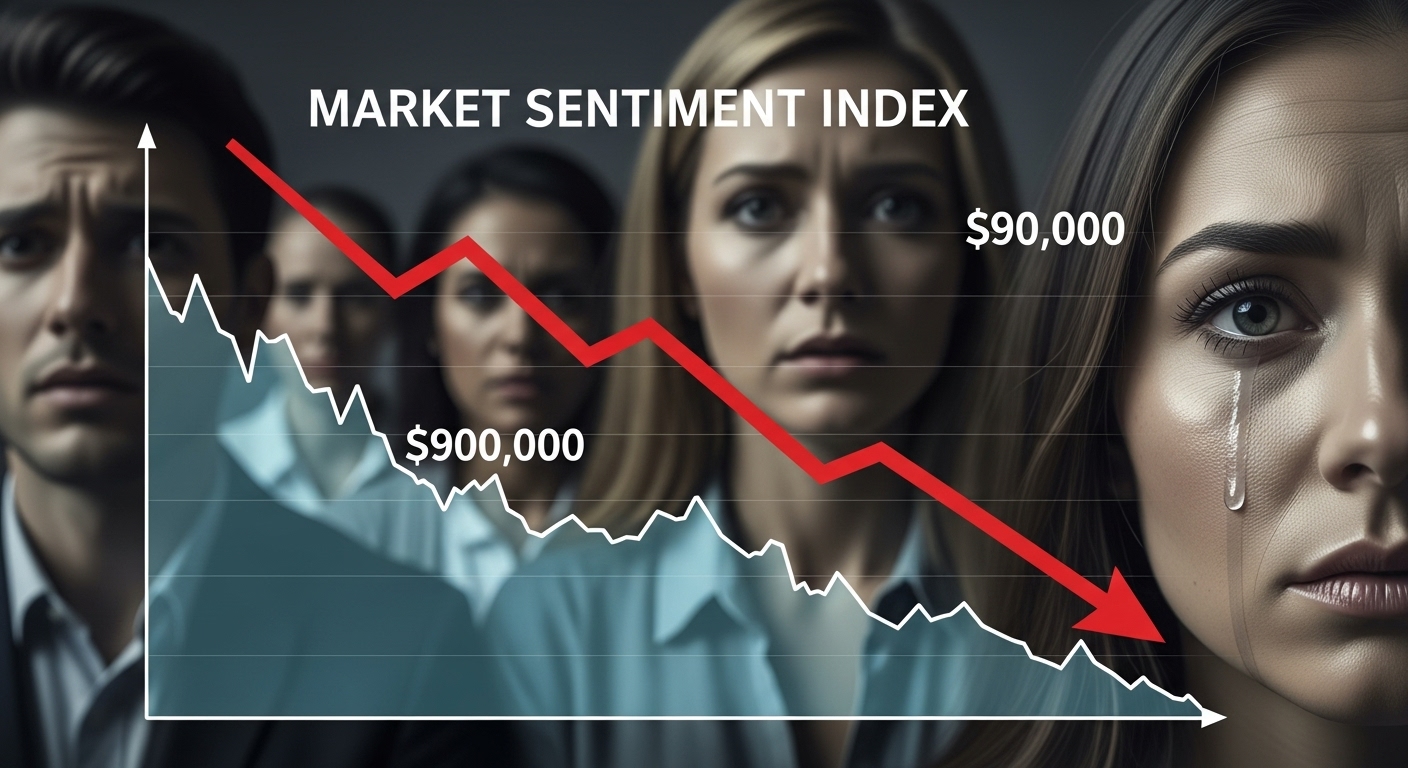Bitcoin Drops Below $90K Why Market Mood Turns Sour
Bitcoin drops below $90,000, signaling a shift in market mood. Learn why sentiment is souring and what it means for crypto investors.

Bitcoin has always been an asset that captures global attention, not only because of its technological roots but also because of its dramatic price movements. Whenever the price crosses key thresholds, public sentiment often swings in equally dramatic ways. Bitcoin Drops Below $90K. The idea of Bitcoin dropping below $90,000 creates a wave of psychological and emotional reactions, even if the level itself is largely symbolic.
These symbolic thresholds have shaped market narratives for years, just as they did when Bitcoin slipped below $20,000 after the 2021 cycle or when it plunged from record highs beyond $60,000. A move beneath $90,000 represents more than a numerical loss; it reflects a shift in expectations, mood, and confidence.
Why a Bitcoin drop below $90,000 matters
Bitcoin is frequently discussed in the context of rounded, easily recognizable numbers. Levels such as $50,000, $75,000, $100,000, and $150,000 often appear more meaningful than they actually are. When Bitcoin approaches $100,000, anticipation grows rapidly, and many assume the breakthrough is inevitable. Consequently, when the price reverses direction and falls below $90,000 instead, it creates a strong sense that momentum has shifted.
The emotional impact of breaking below $90,000 lies in the collective expectations of investors. Long-term believers may begin to wonder whether the anticipated six-figure level will require more time to achieve. Short-term traders often reassess strategies, sensing that the market’s momentum has weakened. Newer participants, particularly those who bought near the top, become anxious as unrealized losses grow. The result is an atmosphere in which caution replaces confidence and negative sentiment spreads more quickly than rational analysis.
This drop also affects leveraged traders. Bitcoin bull markets are usually accompanied by aggressive use of derivatives, where traders borrow to amplify potential gains. When the price falls sharply, those leveraged positions come under pressure, and if the decline accelerates, they can be liquidated by exchanges automatically. Forced liquidations add further downward pressure, creating cascading declines. Even if the initial move below $90,000 is moderate, leverage can turn it into a much sharper and more dramatic plunge, amplifying the sense of panic and feeding the souring mood.
What falling below $90,000 reveals about market sentiment

A decline under a psychologically important level reflects a deeper shift in the beliefs and expectations of market participants. Bitcoin’s transparent blockchain allows analysts to observe how various groups behave during significant corrections and whether fear has begun influencing decisions.
On-chain data can show whether short-term holders are sending coins to exchanges, which typically indicates an intention to sell. If the majority of these transfers come from wallets that purchased recently at higher prices, the pattern suggests capitulation among newer investors. Long-term holders may behave differently; they tend to move coins less frequently and usually react slower to mood changes. If they remain steady, the correction may reflect short-term overexuberance rather than a structural breakdown.
Exchange inflows, realized losses, and the cost basis of different cohorts can indicate how widespread the pessimism has become. If long-term holders begin realizing large losses as well, it may imply a deeper shift into a true bearish phase rather than a temporary correction. Bitcoin’s history shows that even severe downturns can be moments of accumulation for those who maintain long time horizons, although the emotional intensity of the moment often obscures this perspective.
Sentiment also becomes visible through funding rates, options pricing, and futures activity. In euphoric phases, funding rates tend to rise as many traders take long positions. When Bitcoin drops below $90,000, funding rates often turn negative, showing that traders are paying a premium to short the market rather than to long it. Options data can reveal a surge in demand for protective puts, suggesting that participants expect further volatility or seek protection against deeper losses. The speed at which these metrics shift reinforces the idea that the crypto market mood has changed, replacing optimism with defensive caution.
Macro forces that intensify or trigger a souring mood
Bitcoin’s performance does not depend solely on internal market mechanics. Broader macroeconomic conditions often play an even more significant role in shaping sentiment. When central banks raise interest rates to combat inflation, traditional investments such as bonds become more appealing. During such periods, risk-heavy assets like Bitcoin, tech stocks, and high-growth equities often struggle to maintain upward momentum. A falling Bitcoin price below $90,000 can reflect larger shifts in global liquidity, appetite for risk, and investor confidence.
Periods of high inflation can complicate Bitcoin’s narrative as “digital gold.” If Bitcoin falls while traditional safe-haven assets rise, investors may question whether the asset is behaving as a reliable store of value. This does not undermine its long-term potential but highlights the difference between long-term conviction and short-term behavior in response to economic pressure.
Regulation also plays a powerful role in shaping sentiment. Headlines about stricter rules for exchanges, new taxes, or uncertainty regarding Bitcoin ETFs can push nervous investors toward selling. At the same time, positive regulatory developments or inflows into institutional products can increase confidence. When Bitcoin falls below $90,000, observers often search for regulatory catalysts even when the correction is primarily technical or emotional. This interplay between perception and reality is part of why market mood can deteriorate quickly.
Opportunities that appear when the mood sours

It is natural for fear to spread when Bitcoin’s price falls sharply, especially when it breaks a level viewed as significant. Yet historically, long-term opportunities have emerged precisely at times when sentiment is most negative. Bitcoin’s greatest long-term gains have tended to follow periods of pessimism, not periods of euphoria.
Investors who use strategies like dollar-cost averaging often welcome downturns because they can accumulate more Bitcoin at lower prices. By consistently purchasing over time, regardless of market mood, they avoid the emotional turmoil of trying to time tops and bottoms. The psychological relief of following a predetermined plan can be just as valuable as the financial benefit.
Risk management becomes especially important in periods where Bitcoin drops below critical thresholds. Investors who avoid excessive leverage and allocate capital thoughtfully are better equipped to handle volatility. Those who prepare emotionally and strategically are less likely to panic during rapid declines, allowing them to act with clarity rather than fear. When market mood turns sour, individuals with a long-term perspective can respond from a position of strength.
How traders and investors should respond to a sharp decline
A sharp price drop is a test of emotional discipline. During fast sell-offs, traders often abandon reason and react impulsively. Without a plan, fear and urgency take control, leading to poor decisions. Whether an individual is a long-term holder or a short-term trader, the best defense is a strategy established long before the market turns volatile.
Investors should decide in advance what levels will prompt buying, holding, or reducing exposure. This type of planning reduces emotional stress because decisions have already been made during calmer times. Long-term holders might choose to remain steady as long as the fundamental narrative of Bitcoin remains unchanged. Short-term traders might rely on technical indicators or trend shifts to guide their actions. When the plan is clear, the market’s fluctuations become easier to interpret rather than overwhelming.
Emotional pitfalls often appear during sharp corrections. Individuals may attempt to “revenge trade” after losses, taking much larger risks in hopes of quick recovery. This strategy almost always leads to deeper losses. Panic selling is another common reaction, especially when headlines amplify fear. Investors who understand that sharp drops are part of Bitcoin’s nature are less likely to sell impulsively. A rational response requires stepping back, analyzing the broader context, and refocusing on long-term goals rather than immediate emotions.
See More: Bitcoin dives to six month low amid US economic uncertainty again
Final thoughts
A moment where Bitcoin drops below $90,000 in sign of souring mood represents a temporary shift, not the end of its journey. Bitcoin’s history is filled with dramatic corrections followed by periods of renewed strength. Each downturn contributes to the asset’s maturity, flushing excess leverage from the system and resetting expectations.
While market mood may sour quickly, history shows that sentiment can recover just as quickly. Understanding the psychological, technical, and macroeconomic factors behind such price movements helps investors think more clearly in turbulent times. A drop below $90,000 is one chapter in Bitcoin’s ongoing evolution—not the final chapter, nor the defining one.
The most important factor is how individuals respond. With preparation, emotional awareness, and a long-term perspective, traders and investors can navigate volatility with confidence. Bitcoin’s journey will continue to include extreme highs and sudden lows, but those who approach it with clarity and strategy are better positioned to benefit from its long-term growth, whether the price is above $90,000 or far below it.




